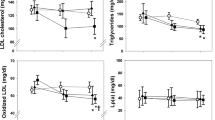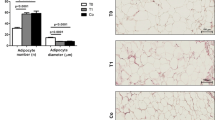Abstract
Background
Small dense low-density lipoprotein (LDL) are atherogenic particles frequently observed in obese patients. Fatty acids modulate LDL. Objective of this study was to determine the relations between plasma phospholipid fatty acid composition and the presence of small dense LDL particles in morbidly obese patients treated with laparoscopic gastric banding (LAGB).
Methods
Small dense LDL, plasma lipids, lipoproteins, apoproteins, and phospholipid fatty acid composition (a marker of dietary fatty acid intake) were quantified before and 12 months after surgery in four men and 11 women who were morbidly obese and (BMI > 40 kg/m2) eligible for surgery, consecutively treated with LAGB at the Department of Medical and Surgical Sciences of the University of Padova.
Results
BMI was 48.3 ± 4.8 kg/m2 before and 36.1 ± 5.5 kg/m2 after LAGB. Plasma triglycerides and apoprotein E levels significantly decreased, while HDL cholesterol significantly increased after LAGB. A reduction of small dense LDL with an increase of LDL relative flotation (0.34 ± 0.04 before vs 0.38 ± 0.03 after LAGB, p < 0.001) was also observed. These modifications were neither related to weight reduction nor to changes in phospholipid fatty acid composition, but they were associated to triglyceride reduction, which explained 76.7% of the LDL relative flotation variation.
Conclusion
Weight loss obtained by LAGB in morbidly obese subjects was accompanied by triglyceride reduction, high-density lipoprotein increase, and an improvement of the atherogenic LDL profile. Triglyceride reduction, but not the extent of weight loss or dietary fatty acid modifications, is the determinant of modifications of LDL physical properties in these patients.

Similar content being viewed by others
References
Manzato E, Zambon S, Zambon A, et al. Lipoprotein sub-fraction levels and composition in obese subjects before and after gastroplasty. Int J Obes Relat Metab Disord 1992;16:573–8.
Zambon A, Sartore G, Passera D, et al. Effects of hypocaloric dietary treatment enriched in oleic acid on LDL and HDL subclass distribution in mildly obese women. J Intern Med 1999;246:191–201.
Kwiterovich PO Jr. Clinical relevance of the biochemical, metabolic, and genetic factors that influence low-density lipoprotein heterogeneity. Am J Cardiol 2002;90(Suppl):30i–47i.
Carmena R, Duriez P, Fruchart J-C. Atherogenic lipoprotein particles in atherosclerosis. Circulation 2004;109(Suppl I):III–2–7.
Buchwald H, Avidor Y, Braunwald E, et al. Bariatric surgery: a systematic review and meta-analysis. JAMA 2004;292:1724–37.
Sjöström L, Lindroos A-L, Peltonen M, for the Swedish Obese Subjects Study Scientific Group, et al. Lifestyle, diabetes, and cardiovascular risk factors 10 years after bariatric surgery. N Engl J Med 2004;351:2683–93.
Rudel LL, Parks JS, Hedrick CC, et al. Lipoprotein and cholesterol metabolism in diet-induced coronary artery atherosclerosis in primates. Role of cholesterol and fatty acids. Prog Lipid Res 1998;37:353–70.
Dreon DM, Fernstrom HA, Campos H, et al. Change in dietary saturated fat intake is correlated with change in mass of large low-density lipoprotein particles in men. Am J Clin Nutr 1998;67:828–36.
Vessby B. Dietary fat, fatty acid composition in plasma and the metabolic syndrome. Curr Opin Lipidol 2003;14:15–9.
National Institute of Health Consensus Development Conference Statement. Gastrointestinal surgery for severe obesity. Bethesda: National institutes of Health; 1991.
Favretti F, Cadiere GB, Segato G, et al. Laparoscopic banding: selection and technique in 830 patients. Obes Surg 2002;12:385–90.
Busetto L, Segato G, De Marchi F, et al. Outcome predictors in morbidly obese recipients of an adjustable gastric band. Obes Surg 2002;12:83–92.
Favretti F, Cadiere GB, Segato G, et al. Laparoscopic adjustable silicone gastric banding (Lap-Band): how to avoid complications. Obes Surg 1997;7:352–8.
Busetto L, Valente P, Pisent C, et al. Eating pattern in the first year following adjustable silicone gastric banding (ASGB) for morbid obesity. Int J Obes Relat Metab Disord 1996;20:539–46.
Roschlau P, Bernt E, Gruber W. Enzymatische bestimmung des gesamtcholesterins im serum. Klin Chem Klin Biochem 1974;12:403–7.
Wahlefeld AW. Triglycerides determination after enzymatic hydrolysis. In: Bergmeyer HU, editor. Methods of enzymatic analysis. New York: Academic; 1976. p. 1831–5.
Hainline A, Karon J, Lippell K, editors. In: Lipid research clinics program. Lipid and lipoprotein analysis. Manual of laboratory operations. 2nd ed. Washington DC: US Department of Health and Human Service; 1982. p. 63–77.
Friedewald WT, Levy RI, Fredrickson DS. Estimation of the concentration of low density lipoprotein cholesterol in plasma, without use of the preparative ultracentrifuge. Clin Chem 1972;18:499–502.
Chung BH, Segrest JP, Marjory JR, et al. Single vertical spin density gradient ultracentrifugation. In: Segrest JP, Albers JJ, editors. Methods in enzymology. Orlando: Academic; 1986. p. 181–209.
Folch J, Lees M, Stanley GHS. A single method for the isolation and purification of total lipids from animal tissue. J Biol Chem 1957;226:497–507.
Morrison WR, Smith LM. Preparation of fatty acid methyl esters and dimethylacetals from lipids with boron fluoride-methanol. J Lipid Res 1964;5:600–8.
Busetto L, Pisent C, Rinaldi D, et al. Variation in lipid levels in morbidly obese patients operated with the LAP-BAND adjustable gastric banding system: effects of different levels of weight loss. Obes Surg 2000;10:569–77.
Busetto L, Sergi G, Enzi G, et al. Short-term effects of weight loss on the cardiovascular risk factors in morbidly obese patients. Obes Res 2004;12:1256–63.
Yusuf S, Hawken S, Ounpuu S, on behalf of the INTERHEART Study Investigators, et al. Effect of potentially modifiable risk factors associated with myocardial infarction in 52 countries (the INTERHEART study): case control study. Lancet 2004;364:937–52.
Lind L, Vessby B, Sundstrom J. The apolipoprotein B/AI ratio and the metabolic syndrome independently predict risk for myocardial infarction in middle-aged men. Arterioscler Thromb Vasc Biol 2006;26:406–10.
Executive Summary of The Third Report of The National Cholesterol Education Program (NCEP). Expert panel on detection, evaluation, and treatment of high blood cholesterol in adults (Adult Treatment Panel III). JAMA 2001;285:2486–97.
Manzato E, Zambon S, Zambon A, et al. Levels and physicochemical properties of lipoprotein subclasses in moderate hypertriglyceridemia. Clin Chim Acta 1993;219:57–65.
Lapolla A, Sartore G, Della Rovere GR, et al. Plasma fatty acids and lipoproteins in type 2 diabetic patients. Diabetes Metab Res 2006;22:226–31.
Kathiresan S, Otvos JD, Sullivan LM, et al. Increased small low-density lipoprotein particle number: a prominent feature of the metabolic syndrome in the Framingham heart study. Circulation 2006;113:20–9.
Zambon A, Austin MA, Brown BG, et al. Effect of hepatic lipase on LDL in normal men and those with coronary artery disease. Arterioscler Thromb Vasc Biol 1993;13:147–53.
Ebenbichler CF, Laimer M, Kaser S, et al. Relationship between cholesteryl ester transfer protein and atherogenic lipoprotein profile in morbidly obese women. Arterioscler Thromb Vasc Biol 2002;22:1465–9.
Kaser S, Laimer M, Sandhofer A, et al. Effects of weight loss on PLTP activity and HDL particle size. Int J Obes Relat Metab Disord 2004;28:1280–2.
Author information
Authors and Affiliations
Corresponding author
Rights and permissions
About this article
Cite this article
Zambon, S., Romanato, G., Sartore, G. et al. Bariatric Surgery Improves Atherogenic LDL Profile by Triglyceride Reduction. OBES SURG 19, 190–195 (2009). https://doi.org/10.1007/s11695-008-9644-2
Received:
Accepted:
Published:
Issue Date:
DOI: https://doi.org/10.1007/s11695-008-9644-2




